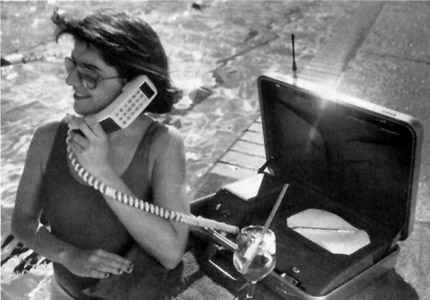
phone
cards
all you need to know about
 |
|
phone | |
all you need to know about | |||
Mobile Telephone History
Page 10 >>
In February, 1983 Canadian cellular service began. This wasn't AMPS but something different. Alberta Government Telephones, now Telus (external link), launched the AURORA-400 system , using GTE and NovAtel equipment. This so called decentralized system operates at 420 MHZ, using 86 cells but featuring no handoffs. As David Crowe explains, "It provides much better rural coverage, although its capacity is low." You had, in other words, a system employing frequency reuse, the defining principle of cellular, but no handoffs between the large sized cells. This worked well for a rural area needing wide area coverage but it could not deliver the capacity that a system with many more small cells could offer, since more cells means more customers served. On October 12, 1983 the regional Bell operating company Ameritech began the first United States commercial cellular service in Chicago, Illinois. This was AMPS, or Advanced Mobile Phone Service, which we've discussed in previous pages. United States cellular service developed from this AT&T model, along with Motorola's analog system known as Dyna-TAC(external link), first introduced commercially in Baltimore and Washington D.C. by Cellular One on December 16, 1983. Dyna-Tac stood for, hold your breath, Dynamic Adaptive Total Area Coverage. In 1982 the Bell System had grown to an unbelievable 155 billion dollars in assets (256 billion in today's dollars), with over one million employees. By comparison, Microsoft in 1998 had assets of around 10 billion dollars. On August 24, 1982, after seven years of wrangling with the federal justice department, the Bell System was split apart, succumbing to government pressure from without and a carefully thought up plan from within. Essentially, the Bell System divested itself. In the decision reached, AT&T kept their long distance service, Western Electric, Bell Labs, the newly formed AT&T Technologies and AT&T Consumer Products. AT&T got their most profitable companies, in other words, and spun off their regional Bell Operating Companies or RBOCs. Complete divestiture took place on January, 1, 1984. After the breakup new companies, products, and services appeared immediately in all fields of American telecom, as a fresh, competitive spirit swept the country. The Bell System divestiture caused nations around the world to reconsider their state owned and operated telephone companies, with a view toward fostering competition in their own countries. But back to cellular. NMT -- The first multinational cellular system Europe saw cellular service introduced in 1981, when the Nordic Mobile Telephone System or NMT450 began operating in Denmark, Sweden, Finland, and Norway in the 450 MHz range. It was the first multinational cellular system. In 1985 Great Britain started using the Total Access Communications System or TACS at 900 MHz. Later, the West German C-Netz, the French Radiocom 2000, and the Italian RTMI/RTMS helped make up Europe's nine analog incompatible radio telephone systems. Plans were afoot during the early 1980s, however, to create a single European wide digital mobile service with advanced features and easy roaming. While North American groups concentrated on building out their robust but increasingly fraud plagued and featureless analog network, Europe planned for a digital future.  The United States suffered no variety of incompatible systems. Roaming from one city or state to another wasn't difficult like in Europe. Your mobile usually worked as long as there was coverage. Little desire existed to design an all digital system when the present one was working well and proving popular. To illustrate that point, the American cellular phone industry grew from less than 204,000 subscribers in 1985 to 1,600,000 in 1988. And with each analog based phone sold, chances dimmed for an all digital future. To keep those phones working (and producing money for the carriers) any technological system advance would have to accommodate them. The Rise of GSM Europeans saw things differently. No new telephone system could accommodate their existing services on so many frequencies. They decided instead to start a new technology in a new radio band. Cellular structured but fully digital, the new service would incorporate the best thinking of the time. They patterned their new wireless standard after landline requirements for ISDN, hoping to make a wireless counterpart to it. The new service was called GSM.
|